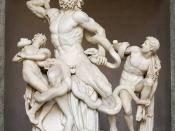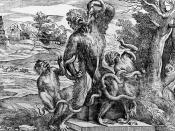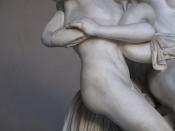Laocoon and His Sons, also known as the Laocoon group, is most likely the original 1st century CE or a Roman copy of the 1st century CE. It was carved from white marble and at its highest point measures eight feet high (Stokstad 39). The statue is attributed to Hagesandros, Polydoros, and Athanadoros from the island of Rhodes and shows a priest, by the name of Laoccon, and his sons Antiphantes and Thymbraeus being strangled by a serpent (Sullivan). For many years the story of Laocoon, and thus the desired interpretation of this sculptureÃÂs look have been under much scrutiny.
One of the major discoveries of the Italian Renaissance, this sculptural grouping was found in Rome in 1506 in the ruins of Titus' palace (Sullivan). It depicts a scene mentioned in HomerÃÂs account of the Trojan War. As the story goes, the Trojan priest Laocoon warned his people of an invasion by the Greeks (Stokstad).
He told them not to accept the GreekÃÂs sudden gift and suggested that there was something shady about the Trojan horse (Lahanas). This enraged the goddess Athena, who sided with the Greeks for this particular war. She and Poseidon therefore sent serpents to strangle and kill Laocoon and his sons while walking along the beach. Although he told the truth, Athena was angered and murdered him so that the secret of the Trojan horse would remain safe (Stokstad). Because Laocoon had tried to warn the Trojan citizens of the danger of bringing in the wooden horse, he incurred the wrath of the gods. A tragic hero, Laocoon represents a virtuous man destroyed by unjust and all too powerful forces (Stokstad).
The main restoration of the piece was done by Giovanni Angelo Montorsoli through the years 1532-1533. He was the one who supplied the...


